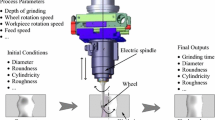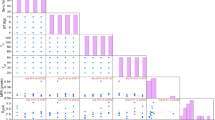Abstract
Grinding is one of the most commonly used operations in the industry. Optimization of the grinding process can significantly improve the product quality and minimize operational costs and production time. Due to nonlinearity and complexity, optimization of the grinding process is one of the most challenging tasks in the field of mechanical engineering. This paper aims to optimize grinding process considering a tri-objective mathematical model to simultaneous optimization of final surface quality, grinding cost and total process time. To obtain non-dominated Pareto optimal solutions, a novel meta-heuristic algorithm named multi-objective dragonfly algorithm is utilized. Besides, an efficient constraint handling technique is implemented to handle complex operational constraints. Furthermore, an experimental case study is solved using the proposed algorithm and the results are compared to NSGA-II in the literature. The results revealed that the proposed algorithm is able to find non-dominated Pareto optimal solutions and make a significant improvement over the existing approaches.
Similar content being viewed by others
References
Wen XM, Tay AAO, Nee AYC (1992) Micro-computer-based optimization of the surface grinding process. J Mater Process Technol 29(1):75–90
Khalilpourazary S, Abdi Behnagh R, Mahdavinejad R, Payam N (2014) Dissimilar friction stir lap welding of Al–Mg to CuZn34: application of grey relational analysis for optimizing process parameters. J Comput Appl Res Mech Eng (JCARME) 4(1):81–88
Khalilpourazary S, Kashtiban PM, Payam N (2014) Optimizing turning operation of St37 steel using grey relational analysis. J Comput Appl Res Mech Eng (JCARME) 3(2):135–144
Khalilpourazari S, Khalilpourazary S (2017) An efficient hybrid algorithm based on Water Cycle and Moth-Flame Optimization algorithms for solving numerical and constrained engineering optimization problems. Soft Comput. https://doi.org/10.1007/s00500-017-2894-y
Khalilpourazari S, Khalilpourazary S (2018) SCWOA: an efficient hybrid algorithm for parameter optimization of multi-pass milling process. J Ind Prod Eng 35(3):135–147
Khalilpourazary S, Payam N (2016) Optimization of the injection molding process of Derlin 500 composite using ANOVA and grey relational analysis. J Comput Appl Res Mech Eng (JCARME) 6(1):39–50
Gholami MH, Azizi MR (2014) Constrained grinding optimization for time, cost, and surface roughness using NSGA-II. Int J Adv Manuf Technol 73(5–8):981–988
Khalilpourazari S, Khalilpourazary S (2017) A lexicographic weighted Tchebycheff approach for multi-constrained multi-objective optimization of the surface grinding process. Eng Optim 49(5):878–895
Khalilpourazari S, Khamseh AA (2017) Bi-objective emergency blood supply chain network design in earthquake considering earthquake magnitude: a comprehensive study with real world application. Ann Oper Res. https://doi.org/10.1007/s10479-017-2588-y
Fazli-Khalaf M, Khalilpourazari S, Mohammadi M (2017) Mixed robust possibilistic flexible chance constraint optimization model for emergency blood supply chain network design. Ann Oper Res. https://doi.org/10.1007/s10479-017-2729-3
Khalilpourazari S, Pasandideh SHR (2017) Multi-item EOQ model with nonlinear unit holding cost and partial backordering: moth-flame optimization algorithm. J Ind and Prod Eng 3(1):42–51
Khalilpourazari S, Pasandideh SHR (2016) Bi-objective optimization of multi-product EPQ model with backorders, rework process and random defective rate. In: 12th international conference on IEEE industrial engineering (ICIE), pp 36–40
Deb K, Agrawal S, Pratap A, Meyarivan T (2000) A fast elitist non-dominated sorting genetic algorithm for multi-objective optimization: NSGA-II. In: International conference on parallel problem solving from nature. Springer, Berlin, pp 849–858
Baskar N, Saravanan R, Asokan P, Prabhaharan G (2004) Ants colony algorithm approach for multi-objective optimisation of surface grinding operations. Int J Adv Manuf Technol 23(5–6):311–317
Krishna AG (2007) Optimization of surface grinding operations using a differential evolution approach. J Mater Process Technol 183(2–3):202–209
Krishna AG, Rao KM (2006) Multi-objective optimisation of surface grinding operations using scatter search approach. Int J Adv Manuf Technol 29(5):475–480
Lee KM, Hsu MR, Chou JH, Guo CY (2011) Improved differential evolution approach for optimization of surface grinding process. Expert Syst Appl 38(5):5680–5686
Lin X, Li H (2008) Enhanced Pareto particle swarm approach for multi-objective optimization of surface grinding process. In: Second international symposium on IEEE intelligent information technology application, IITA’08., vol 2. pp 618–623
Pawar PJ, Rao RV, Davim JP (2010) Multiobjective optimization of grinding process parameters using particle swarm optimization algorithm. Mater Manuf Process 25(6):424–431
Saravanan R, Asokan P, Sachidanandam M (2002) A multi-objective genetic algorithm (GA) approach for optimization of surface grinding operations. Int J Mach Tools Manuf 42(12):1327–1334
Zhang G, Liu M, Li J, Ming W, Shao X, Huang Y (2014) Multi-objective optimization for surface grinding process using a hybrid particle swarm optimization algorithm. Int J Adv Manuf Technol 71(9-12):1861–1872
Slowik A, Slowik J (2008) Multi-objective optimization of surface grinding process with the use of evolutionary algorithm with remembered Pareto set. Int J Adv Manuf Technol 37(7–8):657–669
Patel VK, Savsani VJ (2016) A multi-objective improved teaching–learning based optimization algorithm (MO-ITLBO). Inf Sci 357:182–200
Mirjalili S, Jangir P, Mirjalili SZ, Saremi S, Trivedi IN (2017) Optimization of problems with multiple objectives using the multi-verse optimization algorithm. Knowl Based Syst 134:50–71
Mirjalili SZ, Mirjalili S, Saremi S, Faris H, Aljarah I (2017) Grasshopper optimization algorithm for multi-objective optimization problems. Appl Intell 1–16
Mirjalili S, Jangir P, Saremi S (2017) Multi-objective ant lion optimizer: a multi-objective optimization algorithm for solving engineering problems. Appl Intell 46(1):79–95
Mirjalili S, Saremi S, Mirjalili SM, Coelho LDS (2016) Multi-objective grey wolf optimizer: a novel algorithm for multi-criterion optimization. Expert Syst Appl 47:106–119
Mirjalili S (2016) Dragonfly algorithm: a new meta-heuristic optimization technique for solving single-objective, discrete, and multi-objective problems. Neural Comput Appl 27(4):1053–1073
Bashishtha TK, Srivastava L (2016) Nature inspired meta-heuristic dragonfly algorithms for solving optimal power flow problem. Nature
Hamdy M, Nguyen AT, Hensen JL (2016) A performance comparison of multi-objective optimization algorithms for solving nearly-zero-energy-building design problems. Energy Build 121:57–71
Khalilpourazari S, Khalilpourazary S (2018) A Robust Stochastic Fractal Search approach for optimization of the surface grinding process. Swarm Evolut Comput 38:173–186
Yang XS (2010) Nature-inspired metaheuristic algorithms. Luniver Press, Bristol
Daely PT, Shin SY (2016) Range based wireless node localization using Dragonfly Algorithm. In: Eighth international conference on IEEE ubiquitous and future networks (ICUFN), pp 1012–1015
Hema C, Sankar S (2016) Energy efficient cluster based protocol to extend the RFID network lifetime using dragonfly algorithm. In: International conference on IEEE communication and signal processing (ICCSP), pp 530–534
Pathania AK, Mehta S, Rza C (2016) Multi-objective dispatch of thermal system using Dragonfly Algorithm. Int J Eng Res 5(11):861–866
Bhesdadiya RH, Pandya MH, Trivedi IN, Jangir N, Jangir P, Kumar A (2016) Price penalty factors based approach for combined economic emission dispatch problem solution using Dragonfly Algorithm. In: International conference on IEEE energy efficient technologies for sustainability (ICEETS), pp 436–441
Mohammadi M, Khalilpourazari S (2017) Minimizing makespan in a single machine scheduling problem with deteriorating jobs and learning effects. In: Proceedings of the 6th international conference on software and computer applications. ACM, pp 310–315
Khalilpourazari S, Pasandideh SHR (2018) Multi-objective optimization of multi-item EOQ model with partial backordering and defective batches and stochastic constraints using MOWCA and MOGWO. Oper Res. https://doi.org/10.1007/s12351-018-0397-y
Khalilpourazari S, Pasandideh SHR, Ghodratnama A (2018) Robust possibilistic programming for multi-item EOQ model with defective supply batches: Whale Optimization and Water Cycle Algorithms. Neural Comput Appl. https://doi.org/10.1007/s00521-018-3492-3
Homaifar A, Lai SHY, Qi X (1994) Constrained optimization via genetic algorithms. Simulation 62(4):242–253
Khalilpourazari S, Pasandide SHR, Niaki STA (2016) Optimization of multi-product economic production quantity model with partial backordering and physical constraints: SQP, SFS, SA, and WCA. Appl Soft Comput 49:770–791
Khalilpourazari S, Khalilpourazary S (2018) Optimization of production time in the multi-pass milling process via a Robust Grey Wolf Optimizer. Neural Comput Appl 29(12):1321–1336
Khalilpourazari S, Mohammadi M (2016) Optimization of closed-loop Supply chain network design: a Water Cycle Algorithm approach. In: 12th international conference on IEEE industrial engineering (ICIE), pp 41–45
Taguchi G, Chowdhury S, Wu Y (2005) Taguchi’s quality engineering handbook. Wiley, New Jersey
Author information
Authors and Affiliations
Corresponding author
Ethics declarations
Conflict of interest
The authors declare that they have no conflict of interest.
Rights and permissions
About this article
Cite this article
Khalilpourazari, S., Khalilpourazary, S. Optimization of time, cost and surface roughness in grinding process using a robust multi-objective dragonfly algorithm. Neural Comput & Applic 32, 3987–3998 (2020). https://doi.org/10.1007/s00521-018-3872-8
Received:
Accepted:
Published:
Issue Date:
DOI: https://doi.org/10.1007/s00521-018-3872-8










